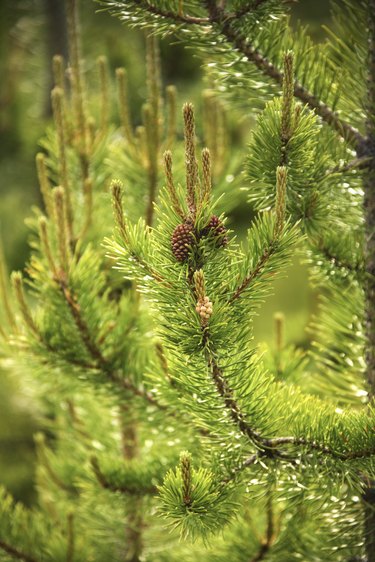
Loblolly pines, also known as North Carolina pines or Arkansas pines, are medium-lived and drought-tolerant evergreens. Loblolly pines grow in humid, warm climates with mild winter weather. While loblolly pines are generally hardy, they are susceptible to diseases and insect infestations that can cause their needles to turn brown.
Insect Causes
Video of the Day
Pine bark beetles are the most destructive pests of loblolly pines. These beetles typically attack pine trees damaged by disease or weather conditions. Fading foliage is the first sign of infestation. Other signs are pitch tubes that ooze resin and dust in bark creases from the beetles' feeding. Needles of infested pines often turn light tan and change to brown or red over time. Microscopic pine wood nematodes are another damaging pest of loblolly pines, usually attacking trees older than six years. Wilting is the first sign of infestation, followed by needle yellowing. Eventually, the needles of infested pines turn brown and the tree dies. Highly susceptible pines such as loblolly can die within 90 days of infestation. Pine wood nematodes are most often transmitted by longhorn beetles, which are most active during April and May.
Video of the Day
Disease Causes
Needle cast is common in most species of pine trees and loblolly pines are no exception. These fungal diseases are most common in humid climates with frequent rainfall, causing infected pines to turn brown from top to bottom. Symptoms appear in the spring on needles from the previous year's growth. Affected needles are shed later in the year and only new growth is left on the tree. Loblolly pines infected with annosus root rot develop thin foliage and brownish-red needles. You may see the black fruiting bodies of the fungus, which spread the disease, on the trunk near the soil line. Pine trees with root rot often develop stringy, brown roots and can blow over easily from the internal structural damage. Needle rust fungus, characterized by tiny white spots, causes the needles to turn brown and drop.
Natural Causes
Winter browning is one of the most common causes of browning in pine trees and other evergreens. During winter, pine trees continue to produce energy from sunlight, which keeps their water requirements high. If moisture is not available, trees can turn brown. Rapidly fluctuating temperatures also may cause needles to brown. Pine trees planted near roadways may turn brown from road salts, which spray onto trees from passing cars. While pine trees are evergreens, they do occasionally turn brown and shed some of their needles during the fall. Seasonal browning and needle drop are most severe after warmer than normal summer and fall temperatures.
Solutions
Pine trees with pine bark beetles or pine wood nematodes should be removed at the first sign of damage to avoid the spread to other nearby pines. Keep your loblolly pine watered and healthy because a weakened tree is less able to fend off these pests. Needle cast may reduce new growth on young pines, but older pines may not suffer severe damage. Fertilizers can speed recovery when trees are defoliated due to needle cast, but no chemical controls are needed. Prevent browning on loblolly pines during the winter by providing your trees with adequate amounts of water in the fall before the first freeze. Avoid pruning brown branches of pines with winter browning, as these branches may still have buds that are viable. Seasonal browning requires no control measures, as trees will eventually grow healthy, green needles.
- United States Department of Agriculture: Pinus Taeda L.
- Iowa State University Extension; Seasonal Needle Loss On Conifers; Christine Engelbrecht; October 2004
- North Carolina State University; Some Common Pine Diseases in North Carolina; L.F Grand, et al.
- Iowa State University Extension; Browning Of Conifer Needles; Christine Engelbrecht; March 2006
- Arizona Cooperative Extension; Pine Bark Beetles; Tom DeGomez, et al.; May 2009
- North Carolina State University; Pine Wood Nematode; R.K Jones, et al.; March 1996